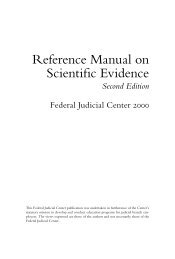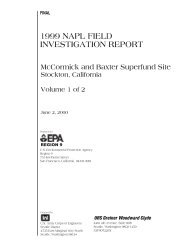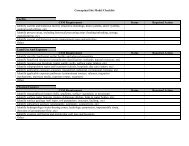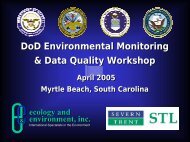Source Zone Delineation Demonstration Report - Triad Resource ...
Source Zone Delineation Demonstration Report - Triad Resource ...
Source Zone Delineation Demonstration Report - Triad Resource ...
You also want an ePaper? Increase the reach of your titles
YUMPU automatically turns print PDFs into web optimized ePapers that Google loves.
6.1.2 Direct Push Technology (DPT)The total estimated cost of the hypothetical DPT investigation is $193,460, approximately 10% less thanthe estimated cost of a HSA investigation. The difference in cost between the DPT and the HSAinvestigative techniques was presented in the previous section, and is primary associated with a reductionin the direct drilling costs and IDW disposal charges.6.2 Adaptive Sampling and AnalysisThe details of the WS/DSITMS and SVE/DSITMS investigative techniques were presented in Sections3.0 and 4.0, respectively, of this report. The distinguishing feature of these adaptive techniques is thatnew sampling locations are selected in the field, based on the real-time evaluation of the analytical datafrom previous locations. This is possible because of the rapid availability of soil contamination due to theon-site DSITMS and real-time update of the CSM. Although the on-site DSITMS enables data evaluationto be conducted in tandem with the fieldwork, its daily cost of $3,500 means that downtime in the field,for any reason, carries a heavy expense burden. For example, the cost of the DSITMS is incurredregardless of reduced sample collection frequency associated with drill-rig mechanical problems orpenetration refusal. For this cost analysis, contingency and/or downtime are not included in the final costestimates.Unlike the two conventional investigative techniques previously discussed, which differ primarily by themethod used to penetrate the vadose zone, the two adaptive techniques are fundamentally different. TheWS/DSITMS investigation relies on closely spaced (vertically) soil samples, on-site analytical results,and rapid evaluation of the results through the use of three-dimensional computer modeling. TheSVE/DSITMS investigation uses VOC time-series data in the extracted vapor at various well locationsscreened across differing intervals in the vadose zone to identify region(s) of contamination to be furthercharacterized under a limited soil sampling program. This approach differs from that used during the OU12 <strong>Source</strong> <strong>Zone</strong> <strong>Delineation</strong> <strong>Demonstration</strong> in that the sequential forward modeling used to furthercharacterize the suspected source has been replaced with a small-scale soil sampling program utilizingDPT with DSITMS. A summary of the major tasks associated with each of these methods ofinvestigation and the estimated cost for each task is summarized in Table 6.3 for WS/DSITMS and inTable 6.4 for SVE/DSITMS.6.2.1 Wireline Sampler/DSITMS (WS/DSITMS)The estimated total cost of the WS/DSITMS investigation is $149,620 (see Table 6-3), approximately$65,630 (30%) less than the cost of the HSA investigation and $43,840 (23%) less than the DPTinvestigation. However, the WS/DSITMS is approximately $24,500 more than the SVE investigation.The reduced cost of the adaptive investigative techniques in comparison with the two conventionalinvestigation techniques is due primarily to a single phase of field investigation; the second phase hasbeen eliminated because data gaps are identified simultaneously with the fieldwork conducted during theinitial phase. Because each new sampling location is selected based on all of the currently available dataMarch 2003 6-6 OU 12 <strong>Demonstration</strong> <strong>Report</strong>Final










